on BMW Grilles, the Meaning of Luxury & Why Toyota Races
When you have an EV, you don’t need a regular grille. So here’s how BMW has transformed its execution for the iX. A record-setting Porsche Taycan. Magna creates modules for building electric pickups. What an 800-v inverter means. The ‘22 Honda Civic Si reviewed. And more.
#electronics
BMW’s 21st Century Kidneys
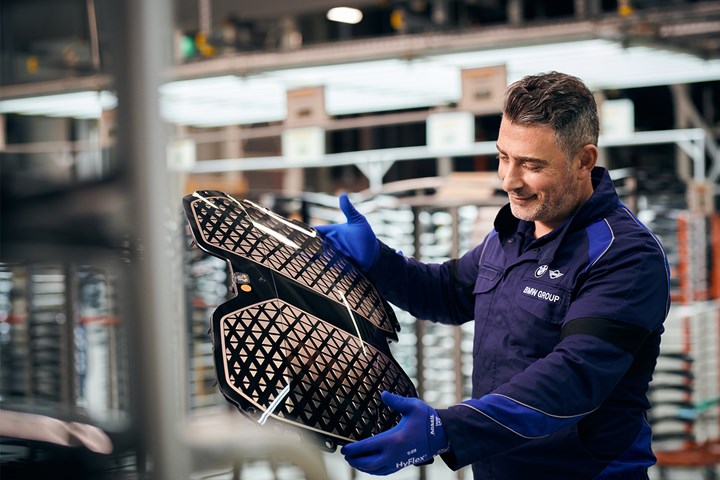
The grille for the BMW iX us a complex molding that includes embedded ADAS sensors. (Image: BMW)
The kidney-shaped grilles characteristic of BMWs go back to the BMW 303 of 1933. Rather than anything resembling a human organ, the chrome grille on that car was like a set of vertically oriented Tylenol capsules positioned side by side.
As years have passed, the shape has morphed. And while it once served a function of letting air into the engine compartment, with the BMW iX electric vehicle, the component’s primary purpose is to protect cameras.
So. . .
The iX grille is a closed, monolithic plastic molded component.
There is a heatable, functional film that’s back-molded with polycarbonate, and flood coated with polyurethane. This is an approach that’s been used for interior components. And now the exterior.
First Time
“This is the first time that combined film back injection molding and polyurethane flooding is being used in the series production of functional components on the exterior, where they are exposed to particularly high stress,” said Michael Fischer, Head of Business Development Technologies at ENGEL AUSTRIA. ENGEL is the system supplier for the production cell producing the grilles.
Because there are electronics embedded in the grille the molding work is performed in ISO class 7 cleanroom conditions.
While the iX grille is certainly a feat of engineering and manufacturing, design-wise it resembles something like Thor’s armor more than it does a pair of kidneys.
///
Porsche’s Ups and Downs
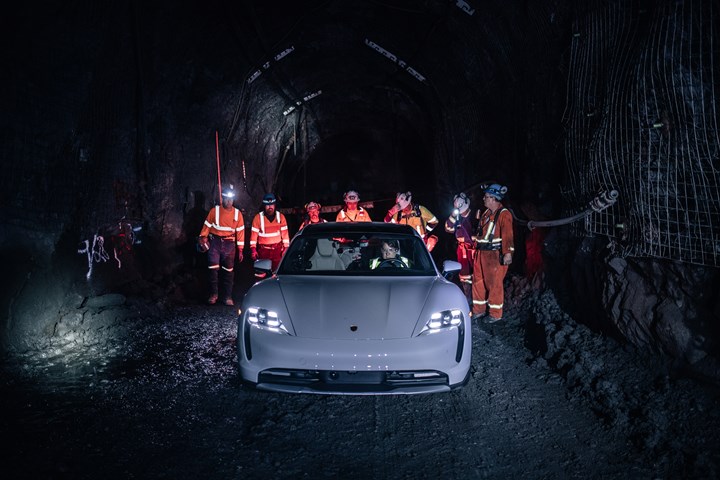
A Porsche Taycan in the Eagle Mine in northern Michigan. Because you never know when you might be 1,774 feet below sea level. (Image: Porsche)
Speaking of German electric vehicles. . .
A Porsche Taycan Cross Turismo has set a record—officially recognized by Guinness World Records—for having gone from the lowest point in the U.S. to one of the highest.
It seems that producer/director J.F. Musial, who has worked on numerous automotive film projects, thought it would be interesting to go from low to high.
For the high portion they drove up Pikes Peak.
For the low portion, they could have gone to the Badwater Basin in Death Valley, 282 feet below sea level.
But they wanted something deeper.
Deeper
So they went to Eagle Mine in Michigan’s upper peninsula. It is a nickel and copper mine. It happens to have a ramp for mining equipment that the Taycan could readily handle (4WD).
“It was fitting to have the Porsche Taycan drive to the bottom of our nickel and copper mine, as both elements are essential to electric vehicles. After numerous risk assessments, safety discussions, and detailed planning, our mine team was up to the challenge. We are proud to have worked with Porsche to safely execute and complete a new world record.”-- Darby Stacey, Managing Director for Eagle Mine
The Taycan descended 1,774 feet below sea level in the mine.
It ascended 14,115 feet at Pikes Peak.
And it drove the 1,402 miles between the two.
(We’re not sure how this is going to help move more EVs in the market, but it must have been quite an adventure.)
///
What’s “Luxury”?
And while on the subject of expensive vehicles. . .
Charlie Chesbrough, Senior Economist and Senior Director of Industry Insights at Cox Automotive, made an interesting observation at the Federal Reserve of Chicago’s 28th Annual Automotive Insights Symposium.
While discussing vehicle prices—which, he noted, were at $47,077 in December, according to Kelley Blue Book—and how in 2012 54% of the vehicles on offer were available for less than $30,000 and now that figure is 19%, he pointed out:
In 2012 Mercedes was the leader in the $50,000+ category in terms of vehicles sold.
Mercedes had 18.3% of that high-end market in 2012.
The leader in the $50K+ market in 2021?
Ford. (That is not a typo.)
It had 19% of the lux market.
Mercedes in 2021? 5.9% of the lux market
And in 2012 Ford had 4.3%.
It is almost a symmetrical flip of the lux share.
“Maybe we need to start rethinking luxury,” Chesbrough speculated. “Is it brand or price?”
///
Magna and Electric Pickups
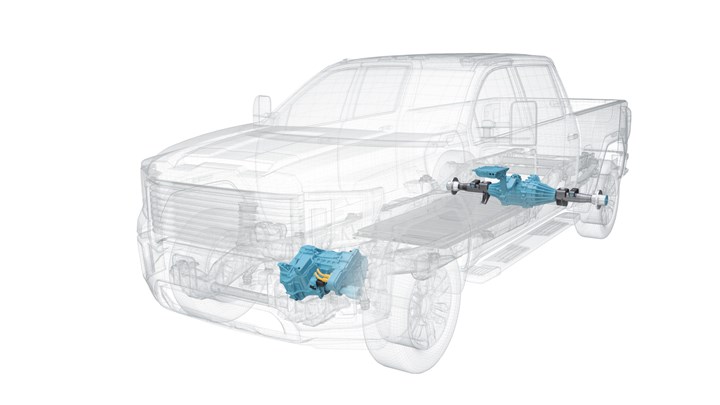
Magna has developed drive systems that allow the development of 3/4- and one-ton electric pickups. (Image: Magna)
“Pickup trucks are at their height of popularity and one of the last segments to become fully electric,” said President of Magna Powertrain, Tom Rucker.
As for the popularity, in 2021:
- Ford F Series: 726,004
- Ram: 569,388
- Chevy Silverado: 519,774
That’s a total of 1,815,166 units.
And the best-selling non-pickup in 2021 was the Toyota RAV4, which came in at 407,739. Or 112,035 fewer than the third-place truck.
The Ford Lightning is imminent. The Chevy Silverado EV is coming in the spring of 2023. And the electric Ram is reportedly coming in 2024.
Addressing the Influx of Trucks
Magna has developed a solution for OEMs who might want to develop an electric pickup.
It has developed a battery electric 4WD powertrain system for pickup trucks and light commercial vehicles that its named “EtelligentForce.” It is engineered for the front of the vehicle. Then the company’s “eBeam” tech is fitted at the back.
The result is a 4WD system that provides power of 180 kW from the front and 250 kW from the rear or a total peak power of 430 kW.
While this is a turnkey system, it raises a question:
What else might be needed to have an electric pickup?
So we asked Magna.
And learned that there needs to be things including a charge point, on-board charger, DC/DC converter, battery pack, electric drive accessories (e,g,, for the HVAC, cooling pumps) and supervisory vehicle controller.
It is worth noting that some of those things can be sourced from LG Magna or Magna Electronics.
///
SiC for Inverters Explained
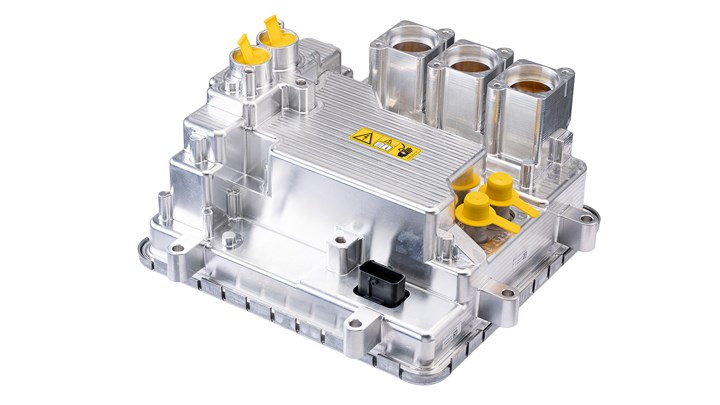
A Vitesco 800-volt inverter for electric vehicles. (Image: Vitesco)
One billion euros is a lot of money. While the number fluctuates, it is approximately $1.1 billion.
Vitesco Technologies announced last week that it had received an order from “a major North American” OEM of more than one billion euros for 800-volt inverters with silicon carbide technology.
For those of you who aren’t electric vehicle engineers (if you are, skip this). . .
An inverter converts DC from the high-voltage battery to AC for the electric machine and vice versa.
But what about 800 volts?
Apparently, nowadays 400 volt inverters are the norm, and by going to 800 volts, the amount of time needed to charge a battery is greatly reduced. Perhaps to 80% in less than 20 minutes.
What’s more, it enables higher output. It improves the efficiency of the electric drive.
And because Vitesco called out silicon carbide, that has to have some importance.
So we asked what that means.
And learned from Vitesco that “SiC technology” leads to a significant efficiency increase so that for a given range, the size of the battery can be decreased.
The savings in the battery “are higher than the add-on costs in the inverter and electric machine, which leads to overall savings for the 800-volt vehicle system.”
Vitesco points out, “There are vehicles on the market that cover 800-volt inverters with IGBTs.”
Or insulated-gate bipolar transistors.
“Those systems do not benefit from the advantages of 800-volt systems with SiC can have.”
Vitesco maintains that going forward SiC will be the approach for 800-volt inverters.
///
2022 Honda Civic Si
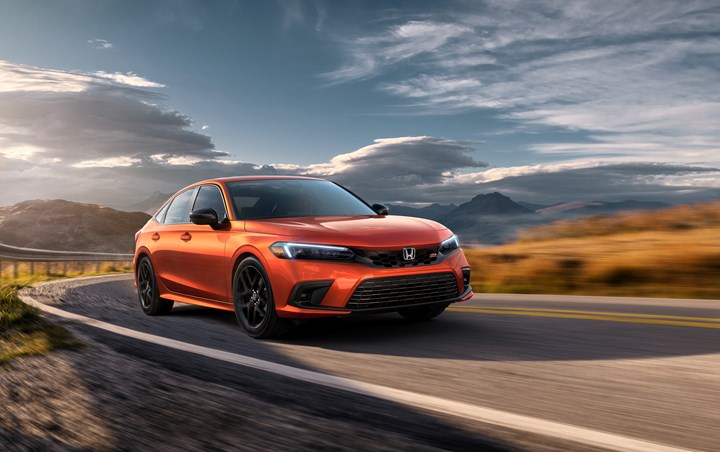
The Civic Si is a sedan that you can take to the grocery store (in case you need an argument on behalf of getting one) and on those twisty roads you’re looking at carving (the actual reason you want one). (Image: Honda)
The Honda Civic Si is a sport compact sedan. Honda has been offering the Si variant of the Civic since the mid-80s, so there is something to be said for consistency in producing a performance variant of the Civic.
What is notable about the ’22 Si is that it has exterior modifications that are functional—as in having a discrete spoiler in the front and a gloss-black spoiler on the edge of the decklid—without being anime exaggerated.
The interior has such things as sport seats that are both cosseting and comfortable and sport pedals—three of them because there is six-speed manual. Only a six speed manual.
You grip the leather-wrapped steering wheel. You engage the aluminum shift nob.
And you go.
One of the things that is pleasantly unusual about the Si is that the transmission strikes me as one that those who (a) are unfamiliar with manuals or (b) not all that chuffed about driving manuals would find to be a surprise.
The clutch and the short throws combine to create something that is eminently drivable for the novice (less likely to stall it) as well as the skeptic (the job gets done with little fuss).
(This is somewhat ironic: If you were teaching someone how to drive a stick, you’d probably think that a car like the Civic Si would be the last thing you’d use. Yet the transmission in that car is so good that it is probably the best thing you could use because the likelihood of stalling is less than in other manuals.)
The transmission is mated to a 1.5-liter turbocharged four that produces 200 hp @ 6,000 rpm and 192 lb-ft of torque at from 1,800 to 5,000 rpm. The curb weight is 2,952 pounds and the body stiffness numbers are up 8% for torsional rigidity and 13% in bending rigidity, so for those who like shifting and who like driving a sport compact sedan as a sport compact sedan will find the Si certainly up to snuff.
Honda has found that the Civic is exceedingly popular with Millennials and Gen Z, so the standard Civic is imbued with a sense of youthful style (sporty without sacrifice). The Si amps that up. And there is a recognition that cost and value are considerations for buyers of a compact sedan overall, and even for those who are looking for a performance variant.
So the Honda personnel aimed at affordability with the Civic Si. The base MSRP sticker is $28,300. The vehicle as driven was coated with the optional Morning Mist paint, $395, so all in, including $995 for destination and handling, and it was still under $30K ($29,690). Certainly affordable.
And fun. (Yes, cars can still be fun.)
///
Why Race?

Toyota Gazoo Racing’s Nasser Al-Attiyah and co-driver Mathieu Baumel on their GR DKR Hilux T1+ after winning the 2022 Dakar Rally by an overall 27minutes, 46 seconds. (Image: Toyota Gazoo Racing)
“A car is an aggregation of many parts. Each part can significantly alter the performance, the feel, and the drive. In races and rallies, many participants build their cars to pursue a single goal, better their vehicles and develop the technologies along the way.
“Toyota Motor Corporation and Toyota Group companies will continue making ever better cars through their motorsports activities.”
That’s Akio Toyoda, after the conclusion of the 2022 Dakar Rally.
Toyota Gazoo Racing took the overall win, and had teams with top five and top 15 finishes.
It is worth noting that Toyoda, in addition to running the company, races, so odds are the company is really committed to the undertaking.
///
GM Expanding Hydrogen Applicability

Using the EMPOWER rapid charger system—powered by hydrogen—EV charging stations can be readily established without the need for a massive, permanent infrastructure build out. (Image: GM)
Batteries and fuel cells are complementary, says Charlie Freese, GM executive director of its HYDROTEC business. That’s the company’s fuel cell technology operation. Ultium is the GM battery brand.
As for the complementarity, Freese:
“Our vision of an all-electric future is broader than just passenger vehicles or even transportation.
“Our energy platform expertise with Ultium vehicle architectures and propulsion components and HYDROTEC fuel cells can expand access to energy across many different industries and users, while helping to reduce emissions often associated with power generation.”
GM is now working with a Utah-based company, Renewable Innovations, on the development of fuel-cell-based generators.
Applications
These generators—with outputs from 60 to 600 kW—have the potential of replacing gas- and diesel-burning generators in a variety of applications, from backup energy for buildings to providing in-theatre power for the U.S. armed forces.
They’re calling it the “MPG”: Mobile Power Generator.
Demonstration programs are being conducted on the MPGs from organizations ranging from the U.S. Army Combat Capabilities Development Command Ground Vehicle Systems Center to the California Energy Commission.
One interesting application:
Electric vehicle charging.
HYDROTEC and Renewable Innovations have developed a rapid charger system that permits rapid charging of up to four vehicles at 150-kW without the need for a build-out of permanent electrical infrastructure.
This means the EMPOWER rapid chargers could be placed at existing service stations or delivered to locations where they might be used for a temporary period of time.
No, you’re not going to be able to get one of these generators for your home.
(At least not yet.)
RELATED CONTENT
-
On Fuel Cells, Battery Enclosures, and Lucid Air
A skateboard for fuel cells, building a better battery enclosure, what ADAS does, a big engine for boats, the curious case of lean production, what drivers think, and why Lucid is remarkable
-
When Automated Production Turning is the Low-Cost Option
For the right parts, or families of parts, an automated CNC turning cell is simply the least expensive way to produce high-quality parts. Here’s why.
-
Choosing the Right Fasteners for Automotive
PennEngineering makes hundreds of different fasteners for the automotive industry with standard and custom products as well as automated assembly solutions. Discover how they’re used and how to select the right one. (Sponsored Content)


.jpg;width=70;height=70;mode=crop)






